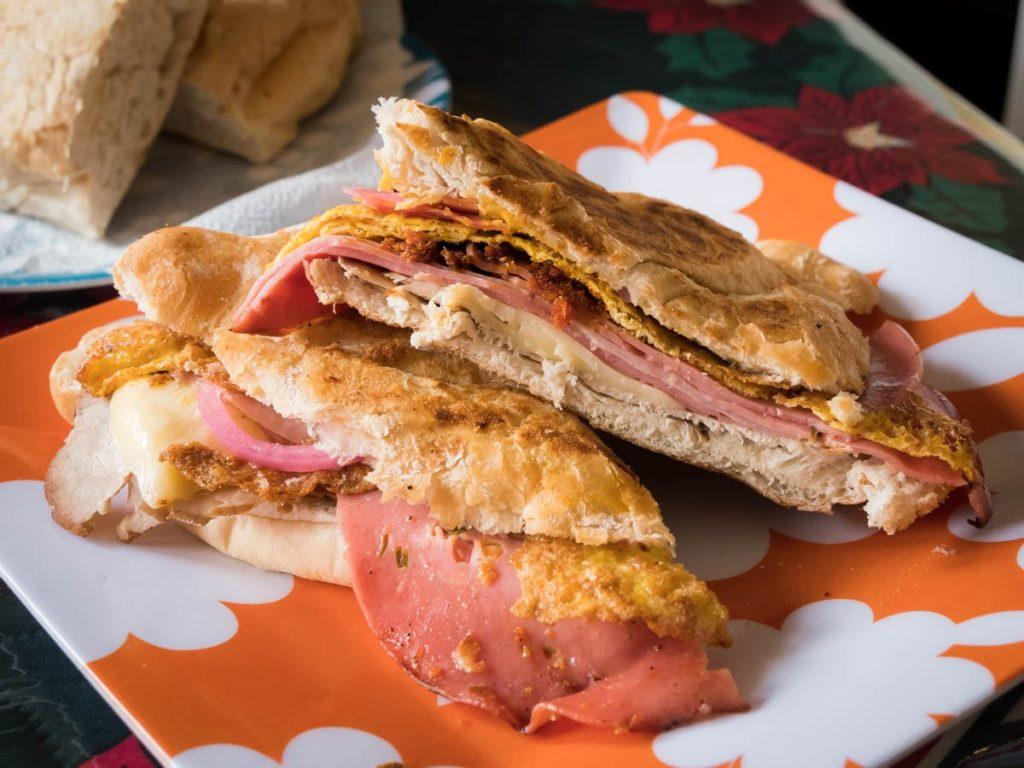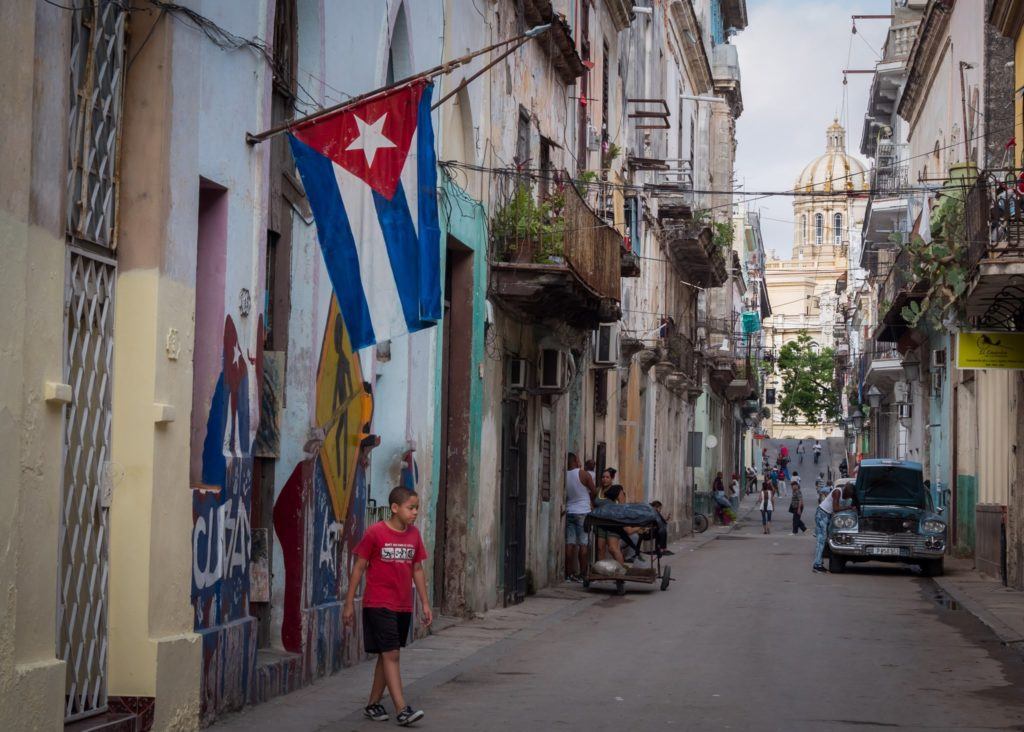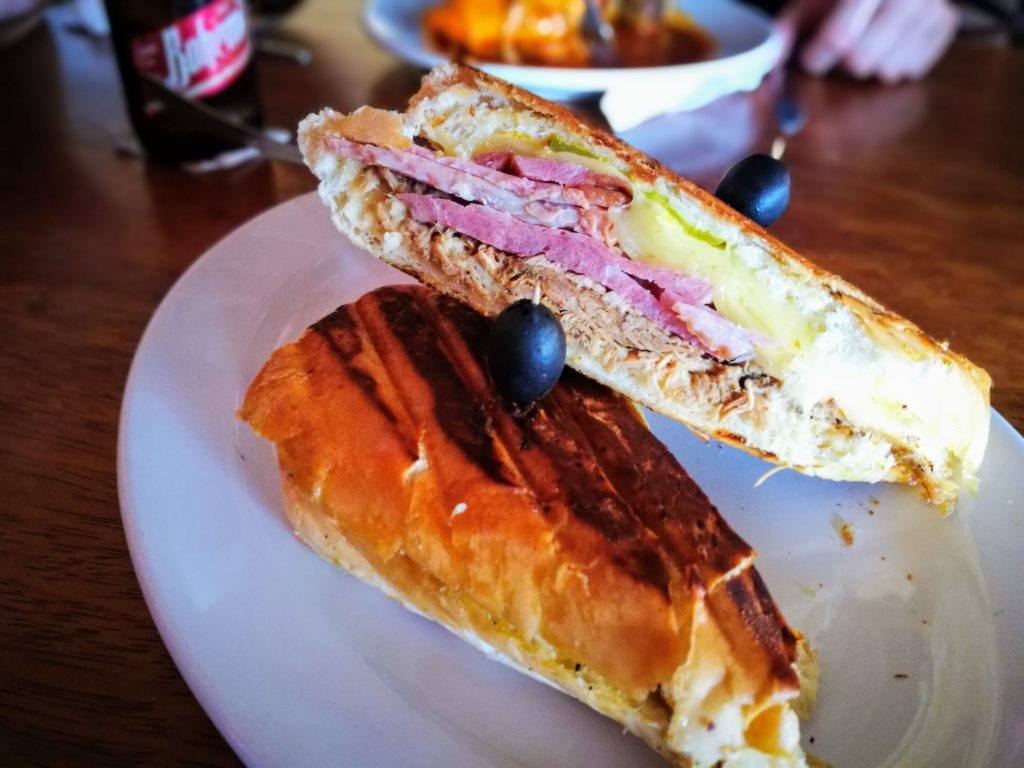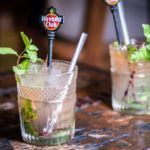History Of Cuban Sandwich: When we went to Cuba in 2018 we were actually surprised to learn that you can’t buy a Cuban sandwich on every street corner. That’s why we decided to jump in and discover the history of the Cuban Sandwich: Who Invented It? and What’s in a Cuban Sandwich that makes it truly a Cuban sandwich?
Below you’ll find our History of Cuban Sandwich podcast as well as the companion article. First, let’s start with the ingredients…
What’s in a Cuban Sandwich?
Cuban sandwiches as we know them today actually stick to a pretty strict formula (if you are a purist) this includes the following:
A true Cuban sandwich needs Cuban bread — What is Cuban bread?
Cuban Bread is a yeast-risen and enriched dough with a little fat (traditionally lard). It’s long, white and soft on the inside, with a light, crispy crust.
As a side note: Cuban bread is best when it is eaten on the same day that it is made, as that tasty tasty lard after a day or so, hardens, and the bread gets dry.
Above all, you need a moist palmetto leaf (also known as cabbage palm) on top of the dough before it’s baked,” apparently – “The dough rises and wraps around the leaf, giving the bread flavour.”

History of Cuban Sandwich – What’s in a Cuban Sandwich?
For toppings you need:
- Mild, smoked ham
- Roast pork marinated in mojo, which blends spices like bitter orange, oregano, cumin, garlic, onion, vinegar, and salt.
- Swiss cheese
- mustard
- sometimes butter
- And if you’re extremely particular, exactly three pickles. Otherwise, just some pickles.
When everything is put together the sandwich can be served 2 ways either fresh or pressed and toasted “a la plancha” with a metal griddle. Plancha (meaning griddle) is a flat-top grill from Mexico & Central America. The double sided plancha (Griddle press) is a device that heats and compresses the sandwich until the bread is nice and crispy on the outside and the cheese is melted on the inside.
In places like Tampa who strongly contend that they are the inventors of the cuban sandwich (I’ll get into that later) they also have the addition of Italian salami on their sandwiches
History Of Cuban Sandwich Podcast
IN THIS EPISODE:
Is the Cuban sandwich truly Cuban? Or a Cuban-American Fusion Dish?
What makes a real Cuban sandwich more than just a pork sandwich?
Plus, salami or no salami? The Tampa vs. Miami debate.
Why not take a listen to some of our other episodes right now by subscribing below.

Listen & Subscribe: iTunes | Spotify | Google Play | Stitcher
RSS: https://feeds.captivate.fm/thedish/
Support: Become a Patron | Tweet: @foodfuntravel | Email: [email protected]
THE BELOW CONTENT IS A COMPANION TO THE PODCAST, NOT A TRANSCRIPT. Listen to the full podcast for a lively discussion of the topic.
History of Cuban Sandwich
Ok, so no one really knows where exactly the Cuban sandwiches originated from, there are some tales that the first Cuban sandwich was made more than 500 years ago the by Taíno tribe in Cuba, that inhabited the island before Europeans arrived. Apparently, the Taínos used casabe bread, made from yucca, to make the dish. Cassava (aka Casabe) Bread is a flatbread, that’s as hard and thin as a cracker, made from cassava flour a flour that is apparently toxic if not cooked properly…so that’s fun!
Instead of pork which was unavailable at the time the tribe would use fish and bird meat inside the centre of two slices of casabe.
When the Spaniards eventually arrived on the island meats such as pork and ham were quickly introduced into the native’s diets, transforming the sandwich into porky heaven. Casabe was substituted for a bread-like alternative also. So traces of the sandwich originate back from the original islanders, but it was only really the beginnings of a sandwich once the Spanish arrived with dough and pork.
Fast forward to the late 1800s and early 1900s, when travel between Cuba and Florida was easy, especially from Key West and Tampa, and Cubans frequently sailed back and forth for employment in cigar factories. Because of this constant and largely undocumented movement of people, culture and ideas, it is really quite impossible to say exactly when or where the Cuban sandwich that we know today originated. But it is thought that the sandwich was a common lunch food for workers in both the cigar factories and sugar mills of Cuba and once they relocated to a similar occupation in America the Cubans were seeking a similar lunch food.

We Visited Downtown Havana In Search Of The History of Cuban Sandwich
As they started to add other popular ingredients of other migrant workers in the factories – mainly Italian, German and Spanish you start to see how the current Cuban sandwich was formed. In Tampa the addition of Salami comes from the Italian influences and Mustard was possibly introduced by the Germans as an ideal condiment that didn’t spoil in the Florida heat.
The first recorded mentions of a distinct Cuban sandwich come from descriptions of workers’ cafés in Ybor City and West Tampa from around 1900 but Miami fiercely lay claim that it was popularised in Miami and not in Tampa, they also say that the addition of salami makes int NOT a Cuban sandwich.

History of Cuban Sandwich – Tampa vs. Miami
So let’s talk about The Rivalry of Tampa VS Miami
So here are the facts – there is recorded evidence of the Cuban Sandwich existing in Tampa in the 1900s. Sure that doesn’t mean that it wasn’t going on in Miami but there’s just not written evidence. Also, It wasn’t really until Fidel Castro’s rise to power in 1959 that a real wave of Cuban immigrants started settling in Miami and bringing with them their culture and cuisine that we see the beginnings of the Cuban sandwich in Miami. The thing we really can give to Miami and their massive Cuban population is that they certainly put Cuban sandwiches on the world map.
So I think the real question lays in whether the addition of the Italian salami no longer makes it a true Cuban sandwich……
This is certainly a hotly debated topic.
But there is another solid claim to origin that Tampa has up their sleeve – the Cuban bread. This is actually something that was invented in Tampa at La Joven Francesca bakery. Established in 1896 by the Sicilian-born Francisco Ferlita who was a Cuban-Spanish-Italian immigrant, it’s said that he created this particular style of bread. It sold for 3-5 cents a loaf and In Ybor City, Tampa. Bread (like milk) used to be delivered every morning. Houses actually had a sturdy nail driven into the doorframe next to the door on which delivery man would impale the fresh loaf of bread.
So it has been a traditional form of bread in Tampa for a long time and right around the time of the first documented sightings of the Cuban sandwich…
………
History of Cuban Sandwich – What’s in a Cuban Sandwich? Conclusion
So sure you can put a bunch of meat, swiss cheese and mustard on any old baguette – but does that make it a Cuban sandwich? Or is it the specific Cuban bread invented by La Joven Francesca bakery that makes it a true Cuban sandwich? Or is it sticking to the whatever goes of the supposed original sandwiches in Cuba? That is entirely up to you to decide…..all I know is I’m hungry!



